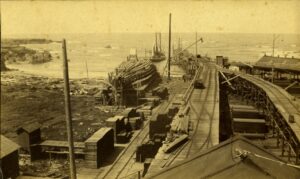One of the dilemmas I get into as a historian is that I start out with an idea for a Kelley House column… “I’m going to write about tugboats and log rafts…” then when researching I get side-tracked and diverted by other interesting facts. Pretty soon I’ve got more than enough research for three or four columns, all relevant to my original search. So, if readers notice a repetitive theme over the next few weeks it’s because this writer found too MUCH information.

In my non-mechanical senior citizen historian mind, I had what I thought was a simple question… “If tying logs together with chains into a raft and pulling the raft to southern California was such a good, what was pulling the raft?”
My knowledge of shipping was based on a childhood alongside the San Diego Harbor watching tugboats move vessels too big to maneuver themselves along crowded waterfront piers. So, simplistically, I thought “Oh, log rafts must have been moved by tugboats too!” Only one problem with this idea…there weren’t any tugboats on the Mendocino Coast. San Francisco Bay had them, Humboldt Bay, the Columbia River, Puget Sound, and even small ports like Bandon Oregon had them, but there was never enough demand to have one stationed near here.
Upcoming Kelley House Calendar columns will discuss the assembly and transport of log rafts and some of the misadventures with them, but when it came time to move the locally produced log rafts, what was used to pull them? Steam schooners it seems. Not being a mariner, I find the idea of a small steam schooner with a chain pulling a raft three times its size hundreds of miles mind boggling. To the folks in the shipping industry it was just another day’s work.
Back to tugboats…I’ve been a fan of tugboats since reading as a child the Little Golden Book called “Scuffy the Tugboat.” As a form of transportation, they’ve been around since the early 1800s. If a vessel were disabled at sea a tug could pull it to port. If a difficult river bar had to be crossed, like the one at the mouth of the Columbia River, a tug could pull a sailing vessel across it to open waters. Barges of coal, grain, or oil could be towed along the coast. A famous towboat along the Pacific Coast was the “Hercules,” which was built in 1907 with a steam engine and resides in the San Francisco Maritime Museum where it is still fully operational.
But in searching museum archives, there was infrequent mention of tugboats locally. Occasionally they would be sent by a salvage company in the city to pull a ship to be saved off the rocks at high tide, but none were stationed locally. The Mendocino Beacon accounts of tugs would mention in September 1898 “…the tug Rescue passed Point Arena pulling a big log raft,” and in July 1938 “…the tug Hercules succeeded in towing an immense log raft…” But reports did not say where the tugs came from. Tugs were like work horses and seldom got much recognition.
So, what did local lumber companies use to pull their log rafts?
I’ll go into more detail in upcoming weeks, but it was the steam schooner that was adapted to do the towing. Excuse me, but this is NOT what I would expect to do that job. These vessels were small, carried deck loads of lumber, general merchandise for stores, and a few passengers and were NOT work horses, but they were here and available. Starting in the 1880s and for the next 35 years they were busy hauling log rafts south.
I know how difficult and unmanageable it is to pull a car behind a vehicle with a chain. It slips and slides with little control. Yet steam schooners were busy pulling 1,000-foot-long log rafts with a chain thrown over their sterns. From Beacon archives it was noted in September of 1889 “…steamers “Emily” and “Noyo” tried to pull a raft of logs from Noyo Harbor but it went to pieces.” It was noted the chain itself cost more than $500. In September 1890, the steamer “Noyo” did make it to San Francisco in three days and did not lose a log. In 1938 the steamer “Benito Juarez” helped the tugboat “Hercules” pull the remains of a broken log raft into San Francisco Bay.
Interestingly, when faced with a maritime disaster the Beacon never named the tugboats involved. The story about another broken log raft in 1938 stated “…the tug continued south and another tug was dispatched,” but no names were given. Look in next week’s column for more about log rafts on the Mendocino Coast.
While The Kelley House Museum is temporarily closed, please check out our webpage and explore our online collections and webstore. www.KelleyHouseMuseum.org